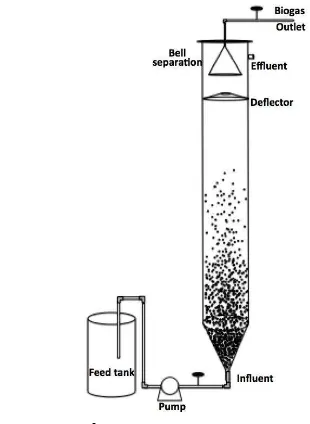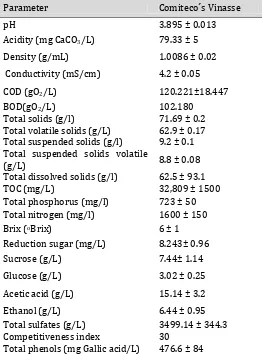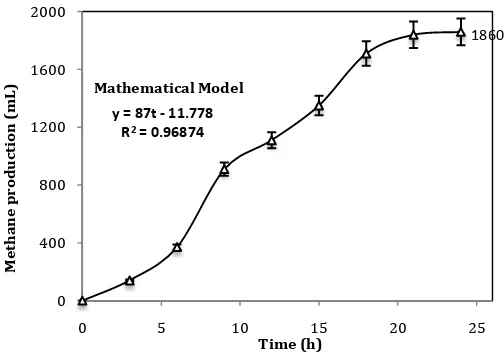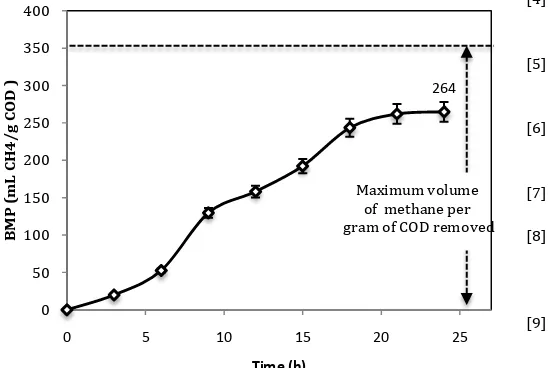Biogas Production Potential from Native Beverage Vinasse of
Mexico
Cruz-Salomón, Abumalé
1, 2; Meza-Gordillo, Rocío
2; Lagunas-Rivera, Selene
3; Ventura-Canseco, Cristina
21 Universidad de Ciencias y Artes de Chiapas. Facultad de Ingeniería. Libramiento Norte Poniente No. 1150. Col Lajas Maciel. Tuxtla Gutiérrez, Chiapas. C.P. 29000.
2Instituto Tecnológico de Tuxtla Gutiérrez. Carretera. Panamericana km. 1080, C.P. 29050.3Catedrática Conacyt, Instituto Tecnológico de México-Instituto Tecnológico de Tuxtla Gutiérrez. Carretera. Panamericana km. 1080, C.P. 29050.
e-mail : dr.abumale@gmail.com
Abstract - This work presents the results of the physicochemical characterization and evaluates the potential of vinasse (a wastewater obtained from local beverage of Chiapas, Mexico) as nutrient source for biogas production by anaerobic digestion in an Upflow Anaerobic Sludge Blanket (UASB) bioreactor. This wastewater contains high level of organic matter, 120.2 ± 18.4 g O2/L of chemical organic demand
(COD), 0.77 biodegradability index (BI), and a ratio 21:1 of C/N. The UASB bioreactor had a working volume of 4 L, at 32 oC, 10 days of
hydraulic retention time (HRT). The COD removal was of 91 %, the production of methane was 1860 mL/day and 264.83 mL CH4/gCOD of
biochemical methane potential (BMP).As such, the UASB bioreactor fed with vinasse can be sustainable alternative for the bioenergy production from wastewater, shifting the paradigm of wastewater management from treatment and disposal to beneficial utilization as well as profitable endeavor .
Keywords– anaerobic digestion, UASB, vinasse,COD,biodegradability, BMP.
Submission: March 21, 2017 Correction: April 11, 2017 Accepted: April 20, 2017 Doi: http://dx.doi.org/10.12777/wastech.5.1.9-14
[How to cite this article Cruz-Salomón, A., Meza-Gordillo, R., Lagunas-Rivera, S., Ventura-Canseco, C. (2017). Biogas Production Potential from Native Beverage Vinasse of Mexico. Waste Technology, 5(1), 9-14. doi:http://dx.doi.org/10.12777/wastech.5.1.9-14]
1. Introduction
The wastewater of ethanol distillation (also called vinasse) are produced and discharged without treatment directly in surface water (rivers, streams or lakes) or even for the direct irrigation of crops, however vinasse disposal into the environment is hazardous and has a considerable pollution potential. Its high COD of approximately 24,500– 120,000 mg/l [1] and a high quantity of dissolved organic carbon (10,000 - 14,000 mg/l approx.) [2], means that its disposal into natural water bodies can cause their eutrophication (a gradual increase in phosphorus, nitrogen and other nutrient concentration in an aquatic ecosystem), which induces a great increase in the concentrations of algae and microorganisms at the surface, avoiding the solar light passage and decreasing the oxygen dissolved in the water bodys until causing anoxia and death of aquatic life. However, due to their origin they contain a great amounts of biomass, organic matter, nitrogen, sugars, among other nutrients[3,4], able to produce biogas by anaerobic digestion in bioreactors UASB, which they have a low cost of implementation and maintenance, reduced excess sludge production, low energy consumption and simplicity in
operation [5,6].In Comitan-Chiapas, Mexico, typical alcoholic beverage called Comiteco was produced by
Agaveamericana L. distilled [7], the process of elaboration
consists of four stages, i.e., Incision of agave hearts, mead collection of the incision of living plant, must fermentation and distillation/rectification. In the distillation/rectification stage, between 15 and 23 L of distillery slops of vinasse are generated for each liter of Comiteco distilled. The principal object of this work is evaluation of vinasse from "Comiteco" and to establish if this residue has potential energy to produce biogas through UASB reactor.
2. Materials and Methods 2.1 Vinasse characterization
suspended solids (TSS), total suspended solids volatile (TSSV), Total dissolved solids (TDS), density,conductivity,acidity, nitrogen, phosphorus and sulfates. The total organic carbon (TOC) was determined by the method of Walkley and Black [9], total phenols were determined by spectral analysis using the Folin-Ciocalteau reagent [10], reducing sugars were determined by 3,5-dinitrosalicylic acid method (DNS) [11]. High Performance Liquid Chromatography (HPLC) Perkin Elmer 200, a refractive index detector and column Hi-Pex H+ was used to quantify sucrose, glucose, acetic acid and ethanol. Water was used as a mobile phase, and a flux of 0.3 mL/min at 30 °C. Quantitation was performed using an external standard. All the analysis were made by triplicate
2.2 UASB Bioreactor
Fig. 1. UASB bioreactor
UASB bioreactor (Figure 1) had volume of 4L operation with cylindrical shape, a height-diameter ratio ( /∅) of 5 and HRT of 10 days. The bioreactor with 1L of anaerobic microbial complex was inoculated 2.52 gTS/mL (from a wastewater plant, San Cristobal de las Casas-Chiapas, Mexico) previously adapted. During this period the following parameters were monitored in the bioreactor: pH (potentiometer HACH model SenSion 3), COD (Standard Methods, [8])and volume of methane production.
2.3. Methane production and Biochemical methane potential
Theoretical production of methane should be calculated with conditions of temperature, under atmospheric pressure which SMA (specific methanogenic activity) mounts are made, you must determine the correction factor [12].
Correction factor for temperature and pressure is calculated using Equation (1) [13]:
= ∗
∗(273 + ) �. (1)
Where K (T) is the correction factor (g COD/ L), P is atmospheric pressure (atm), R is the gas constant (0.08206 atm*L /mol* K), K is the corresponding organic charge to a mol CH4 (64 g COD/mol, that is, 350 mL of CH4 per gram of COD removed) and T is the temperature of the assembly (°C). Theoretical volume of methane was calculated with Eq. (2):
� = 4
( ) �. (2)
Where K (T) is the correction factor (g COD/L), the 4 is COD charge removed (gCOD), the � is theoretical volume produced (L). Considering methane (CH4) production, SMA calculation was made [14]:
�
� � ∗ �� =
� ∗24
� ∗ �. (3)
Where m is the maximum gradient in methane production curve (vol. accumulated CH4 vs time), M is the mass of sludge (g), the theoretical volume VT is produced (L) and 24 is the correction factor for a day.
The technique used for measured of methane production was adapted Raposo et al. [15], this consisted in preparing a solution of 5 % NaOH and phenolphthalein, then added in a test tube and the solution was poured to the crystallizer, where the graduate cylinder was placed inverted.
Technique reported by Harris [16] was used for analyzing the composition of biogas quantifies CO2 and CH4. The BMP was determined from the equation 4 [17]. The accumulated volume of methane was converted to standard conditions for temperature and pressure. The accumulated methane was plotted versus time kinetics until the speed was constant. On this last point constant speed is where the value of BMP (mL CH4/gCOD) took place.
= � 4
�. (4)
Where BMP (mL CH4/gCOD) is the biochemical
methane potential, � CH4 is the methane-accumulated volume (mL CH4) during the experiment in standard conditions for temperature and pressure, OM is the organic matter (gCOD).
The percentage of biodegradability is obtained from equation 5[17].
% =
350� 4 �
100 �. (5)
Where 350 is the theoretical volume of methane per gram of COD removed at normal temperature and pressure (T = 273oK; P =1 atm).
3. Results and discussion 3.1 Physical characterization
was done in accordance with the requirements of NOM-001-ECOL-1996 Mexican official standards are shown in Table 1.
Table 1. Physicochemical characterization of vinasse of Comiteco
Parameter Comiteco´s Vinasse
pH 3.895 ± 0.013
Acidity (mg CaCO3/L) 79.33 ± 5
Density (g/mL) 1.0086 ± 0.02
Conductivity (mS/cm) 4.2 ± 0.05
COD (gO2/L) 120.221±18.447
BOD(gO2/L) 102.180
Total solids (g/l) 71.69 ± 0.2 Total volatile solids (g/L) 62.9 ± 0.17 Total suspended solids (g/l) 9.2 ± 0.1 Total suspended solids volatile
(g/L) 8.8 ± 0.08
Total dissolved solids (g/l) 62.5 ± 93.1
TOC (mg/L) 32,809 ± 1500
Total phosphorus (mg/l) 723 ± 50 Total nitrogen (mg/l) 1600 ± 150
Brix (oBrix) 6 ± 1
Reduction sugar (mg/L) 8.243± 0.96
Sucrose (g/L) 7.44± 1.14
Glucose (g/L) 3.02 ± 0.25
Acetic acid (g/L) 15.14 ± 3.2
Ethanol (g/L) 6.44 ± 0.95
Total sulfates (g/L) 3499.14 ± 344.3 Competitiveness index 30
Total phenols (mg Gallic acid/L) 476.6 ± 84
Microbiological process requires mainly of carbon and nitrogen sources and mineral salts (phosphorus and sulfur), all organic material are able to produce biogas by an anaerobic digestion [18].The stillage of Comiteco
possess of a lot of organic material of BOD (102,000 gO2/L) and has a high biodegradability level (BI), it indicates the percentage of organic material able to be biodegradable [19]. It can be calculated according to the formula BOD/COD or BMP/350 [20], thus has a BI of 0.79 (BOD/COD) and 0.75 (BMP/350), hence 77% in vinasse is organic material biodegradable and can be produced biogas by anaerobic digestion.
The quality and quantity of produced biogas depend on the composition (C / N and S) and the nature of the residue used [21].In the feedstock, optimum ratio of these elements are in rate of C/N 30:1 to 15:1 [22] so vinasse of Comiteco had a ratio 21:1 of C/N being a suitable substrate for methanogenic archaea and efficiently to carry out anaerobic digestion.Archaea Microbial consume more carbon than nitrogen, these elements are the principal sources of energy of methanogenic archaea [23].
Another factor that we need to consider is competitiveness index, is calculated according the COD/SO4-2 formula. If index are more than 10 there are not competition between the sulfate-reducing bacteria and methanogens [24]. In spite of sulfuric acid or ammonium sulfate is used in the process of fermentation broth, Comiteco´s vinasse has a ratio of 30 so there is inhibition by the sulfate-reducing bacteria, by providing methanogenesis this substrate.
A quite considerable amount of reducing sugars in vinasse of Comiteco was determined (8.24 g/L) because this vinasse was originated by fermentation of must by added honey mash and honey brown sugar as a substrate for yeast. Glucose 3.02 g/L and sucrose was found in a concentration of 7.44 g/L by HPLC analysis. This feature provides a high source of carbon to be used by microorganisms in anaerobic digestion and carry out the production of biogas. Sucrose, glucose, fructose, ethanol (6.44 g/L) and acetic acid (15.14 g/L) have not adverse impact on anaerobic digestion. Because they are easily assimilated by microbial consortium [25], as it is shown in Table 2.
Table 2. Biochemical reactions in anaerobic digestion of organic matter at 25oC.
Reactions ∆G0 (kJ/mol) Eq.
C12H22O11 + 9H2O → 4CH3COO- + 4HCO3- + 8H+ + 8H2 - 475.5 (3.1.1) C12H22O11 + 5H2O → 2CH3CH2CH2COO- + 4HCO3- + 6H+ + 4H2 - 554.1 (3.1.2) C12H22O11 + 3H2O → 2CH3COO- + 2CH3CH2COO- + 2HCO3- + 6H+ + 2H2 -610.5 (3.1.3)
C6H12O6 + 4H2O →CH3COO-+ 4H+ + 4H2 -207 (3.1.4)
C6H12O6 + 2H2O →CH3CH2CH2COO-+ 2HCO3- + 3H++ 2H2 -135 (3.1.5) CH3CH2CH2COOH + 2H2O →2CH3COO- + H++ H2 + 48.2 (3.1.6)
CH3CH2OH + H2O → CH3COO- + H+ + 2H2 + 9.6 (3.1.7)
CH3COOH + H2O → CH4 + HCO3- + H+ -31 (3.1.9)
Adapted from van Lier [28].
cultures is range of 6.5 – 8.2 [27]. Stillage of Comiteco pH has 3.9 which does not favor to the process of anaerobic digestion, it was necessary neutralize with NaOH,Ca(OH)2or NaHCO3 before feeding the bioreactor.
However according to the physicochemical profile vinasse of Comiteco has an excellent BI and nutrient content able to be assimilated by anaerobic microorganisms, it just the observed that the bioreactor operated stably throughout the evaluation period, reaching a percentage of removal greater than 90%. However, even when the removal rate was high, COD effluents with 6500 mg/L were generated, This effluent still does not meet the permitted limit requested by the world health organization (WHO)[29], so it is recommended because of that a second anaerobic treatment is recommended to meet the allowable limit.
Fig. 2. UASBbioreactor performance.
3.3 Methane production
Biogas is a mixture of gases produced in the anaerobic reactor. The only economic value gas with biogas is methane. Methane can be used as a fuel, is a natural flammable gas is odorless and burns cleanly (3.31).
CH4+ 2O2 → CO2 + 2H2O (3.31) The reactor UASB was feed with Comiteco vinasseand obtained 1860 mL of (CH4) methane per day, the results are shown in Figure 3.Using eq. 1 the value of K (t) is 2.39 gCOD/L, this value was substituted in eq. 2, to correct the theoretical volume of methane (VT), which was 2.6714 L of CH4 was obtained, this value is considering that all COD removal was converted to methane, however the UASB bioreactor generated biogas with 67 % methane composition, so that multiplying � by the methane composition, corroborates the kinetic of real methane production (� ∗(% 4) ≅ � 4) 1790 ≅1860 mL CH4.
Fig 3. Kinetic methane production
To calculate the SMA, the first step was calculated the slope of the mathematical model of methane production 1.5 (g COD)/(grVSS*day) is reported by [30-32]. The value of SMA was determined as reported by Torres-Lozada and Pérez [14].
Figure 4 shows the profile of methane production from comiteco vinasse. The curve obtained possible to determine the BMP and biodegradability of these.
The numerical value of BMP vinasse is determined from equation 4. The value obtained was 264.83 mL CH4/gCOD. This value is similar to the reporter byJanke et al. [33] and Leite et al. [34] (220-302 mL CH4/gCOD). The anaerobic biodegradability was determined from equation 5, In the mesophilic range the percentage of biodegradability of the comiteco vinasse was 75%, this value corroborates the biodegradability index calculated by the BOD/COD.This value is greater than reported by Robles-González et al. [3] and Moraes et al. [35] (40-50 %). Based in BMP and biodegradability of comiteco vinasse, this residue showed for satisfactory biogas potential for energy production.
Fig. 4. Kinetic biochemical methane potential
4. Conclusions
Vinasse of Comiteco can be considered as biodegradable effluents (BI of 77%) with a high potential to be used as a nutrient source (substrate) has a high competitiveness index, does not present inhibition by the sulfate-reducing bacteria, andit has an excellent nutrient content able of being assimilated by microorganisms, for biogas generation by anaerobic digestion in an upflow anaerobic sludge blanket reactor (UASB). The COD removal was 91 %and biogas produced of 1860 mL/day, is flammable and the composition of biogas in the reactor is 67% of CH4and 33% of CO2, so it can be considered that biogas obtained had a close energy power to 6,000 kcal/m3 and biochemical methane potential of 264.83 mL CH4 per gram of COD removed. As such, the UASB bioreactor fed with vinasse can be sustainable alternative for the bioenergy production from wastewater, shifting the paradigm of wastewater management from treatment and disposal to beneficial utilization as well as profitable endeavor .
Acknowledgments
The authors are grateful to the National Science and Technology Council and to Mexican National Technologic/Tuxtla Gutierrez Technologic Institute for financial support (267951).
References
[1] Benitez, F.J., Real, F.J., Acero, J.L., Garcia, J., Sanchez, M., 2003.Kinetics of the ozonation and aerobic biodegradation of wine vinasses in
[3] V. Robles-González, J. Galíndez-Mayer, N. Rinderknecht-Seijas, M. Poggi- Varaldo. Treatment of mezcal vinasses: A review, Journal of Biotechnology 157 (2012) 524–546.
[4] P.C., Sangave, P.R. Gogate, A.B. Pandit. Ultrasound and ozone assisted biological degradation of thermally pretreated and anaerobically pretreated distillery wastewater. Chemosphere 68(1) (2007) 42–50. [5] A. Jiménez. Kinetic analysis of the anaerobic digestion of untreated
vinasses and vinasses previously treated with Penicillium decumbs. Journal of Enviromental Managment 80, 4 (2006) 303–310. [6] E. Houbron, M.E. Sandoval-Rojas and A.F. Hernández-Muñoz.
Treatment of vinasse in an anaerobic reverse fluidized bed reactor. Rev. Int. Contam. Ambie. 32 (3) (2016) 255-266.
[7] INEGI. (2012). Statistical Yearbook of Chiapas, Internet consultation on April 7, 2015: www.inegi.gob.mx
[8] APHA (American Public Health Association), Standard Methods for the Examination of Water and Wastewater, American Public Health Association/American Water Works Association/Water Environment Federation, Washington, DC, USA, 20th edition, 2005. [9] A. Walkley, I. Black. An examination of the Degtjareff method for
determining organic carbon in soils: Effect of variations in digestion conditions and of inorganic soil constituents, Soil Science 63 (2006) 251-263.
[10] V.I. Singleton, R. Orthofer, R.M. Iamuela-Raventos. Analysis of total phenols and other oxidation substrates and antioxidants by means of Folin-Ciocalteu reagent. Methods Enzymol. 299 (1999)152-178. [11] D. Bello-Gil, E. Carrera-Bocourt, Y. Díaz-Maqueira. (2006).
Determination of total reducing sugars in mixed sugarcane juice using the dinitrosalicylic acid method 3.5, ICIDCA. Derivatives on sugarcane 40(2) (2006) 45-50.
[12] E. Foresti, L. Florencio, A. Van Haandel, M. Zaiat, P. Cavalcanti. Fundaments of anaerobic treatment. Chapter 2. In: Treatment of sewage by anaerobic process and disposition controlled soil. PROSAB, Brazil (1999) 436.
[13] C. Chernicharo. Principles of biological wastewater treatment. Federal University of Minas Gerais. Vol V. Brazil (1997).
[14] P. Torres-Lozada and Pérez, A. Specific methanogenic activity: a control tool and system optimization of anaerobic wastewater treatment. Engineering of Natural Resources and Environment, 9 (2010) 5 -14.
[15] F. Raposo, V. Fernández-Cegrí, M.A. De la Rubia, R. Borja, F. Béline, C. Cavinato, G. Demirer, B. Fernández, M. Fernández-Polanco, J.C. Frigon, R. Ganesh, P. Kaparaju, J. Koubova, R. Méndez, G. Menin, A. Peene, P. Scherer, M. Torrijos, H. Uellendahl, I. Wierinck, V. de Wilde. Biochemical methane potential (BMP) of solid organic substrates: evaluation of anaerobic biodegradability using data from an international inter-laboratory study. J Chem Technol Biotechnol, 86(2011) 1088–1098.
[16] Harris, P. Carbon dioxide content of biogas by Syringr Protocol. Published in Beginners Guide to Biogas, The University of Andalaide, Australia (2010).
[17] S. Zárate-Jiménez, S. Pérez-Fabiel, G. Yáñez-Ocampo, J. Chanona-Soto. Anaerobic digestion of fruit and vegetable waste by mesophilic via laboratory scale. Revista AIDIS 7(2) (2014) 115 – 124.
[18] A. Punal, M. Trevisan, A. Rozzi, J. Lema. Influence of C:N Ratio on the Start-up of Upflow Anaerobic Filter Reactors. Water Res. 34 (2000) 2614–2619.
[19] P. Aguirre. Removal mechanisms of organic matter and nutrients in subsurface flow constructed wetlands. New criteria for the design and operation of constructed wetlands. CPET. Barcelona. (2004)17-29.
[20] A. Cruz-Salomón, R. Meza-Gordillo, A. Rosales-Quintero, C. Ventura-Canseco, S. Lagunas-Rivera, J. Carrasco-Cervantes. Biogas production from a native beverage vinasse using a modified UASB biorreactor. Fuel (2016) DOI: 10.1016/j.fuel.2016.11.046
[21] M. Varnero, J. Arellano. Rational use of organic waste. Ministry of Agriculture (FIA). University of Chile. Faculty of Agricultural and Forestry Sciences, Technical report. Santiago, Chile. 98 (1991). [22] E. Taiganides. Biogas: energy recovery of animal excrement.
Zootecnia 35 (1980) 2-12
[23] P. Smith, F. Bordeaux, A. Wilkie, J. Yang, D. Boone, R. Mah, D. Chynoweth, D. Jerger. Microbial aspects of biogas production. In W. Smith, J. Frank (eds). Methane from biomass: a Systems Approach: (1988) 335-353. London: Elsevier Applied Science Publishers. [24] S. Rizem, G. Lettinga (1988). Methanogenic toxicity of phenolic and
lipidic compounds. In: Proceedings of the 4th Seminar of Anaerobic Wastewater Treatment. University of Valladolid. Valladolid, Spain (1988) 83-110.
[25] M. Mussati, P. Aguirre, N. Scenna. Modeling, simulation and optimization of chemical processes. Chapter XVIII: Modeling of anaerobic digestion process in simple reactors. Ed. Nicolás J. Scenna; National Technology University-CONICET. Santa Fé, Argentina (1999) 697-739
[26] J. Kim, C. Park, T.H. Kim, M. Lee, S. Kim, S.W. Kim and J. Lee. Effects of various pretreatments for en- hanced anaerobic digestion with waste activated sludge. Journal of Bioscience and Bioengineering, 95(2003) 271-275.
[27] D.H. Lee, S.K. Behera, J. Kim and H.S. Park. Methane production potential of leachate generated from Korean food waste recycling facilities: a lab scale study. Waste Management, 29 (2009) 876-882. [28] J.B. van Lier. Biological wastewater treatment: Principles Modelling
and Desing. Edited by M. Henze, M.C.M. van Loosdrecht, G.A. Ekama and Brdjanovic. ISBN: 9781843391883. Published by IWA Publishing, London, UK.(2008).
[29] WHO, Guideline for Discharge of Industrial Effluent Characteristics, vol. 3, WHO, Geneva, 1995, pp. 231–236.
[30] J. Dolfing. Activity measurements as a tool to characterize the microbial composition of methanogenic environments. Journal of Microbiological Methods 4 (1985) 1-12;
[31] J. Field. Operating parameters of anaerobic sludge blanket upflow. Manual Startup and operation of systems with upflow sludge blanket – UASB. Universidad del Valle, CVC. Wageningen Agricultural University (1987);
[32] S. Guiot. A structured model of the anaerobic granule consortium. Water Science Technology 25 (1992) 7, 1-10.
[33] L. Janke, A. Leite, M. Nikolausz, T. Schmidt, J. Liebetrau, M. Nelles and W. Stinner. Biogas production from sugarcane waste: assessment on kinetic challenges for process designing. Int. J. Mol. Sci. 16(2015) 20685-20703.
[34] A.F. Leite, L. Janke, H. Harms, J.W. Zang, W.A. Fonseca-Zang, W. Stinner, M. Nikolausz. Assessment of the variations in characteristics and methane potential of major waste products from the Brazilian bioethanol industry along an operating season. Energy Fuels 29 (2015) 4022–4029.
[35] B.S. Moraes, M. Zaiat, A. Bonomi. Anaerobic digestion of vinasse from
sugarcane ethanol production in Brazil: Challenges and perspectives. Renewable and Sustainable Energy Reviews 44 (2015) 888–903.



